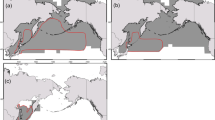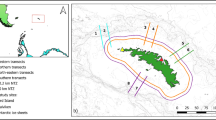Abstract
The causes of the appearance of large blue king crabs (Paralithodes platypus) in Peter the Great Bay for the last decade are discussed. This species is an important commercial resource in the waters of Russian Far Eastern seas, and its general concentrations are related mainly to the sublittoral and upper bathyal zones of the northwestern Bering Sea and the northern Sea of Okhotsk. Until recently, this species has been observed in areas along the continental coast of the northwestern Sea of Japan up to the Peter the Great Bay, where it incidentally showed up in red king crab (P. camtschaticus) and snow crab (Chionoecetes opilio) catches but was also commercially used. This area was considered as the southern periphery of the species range. Since the late 1990s, both male and female blue king crabs have been recorded in trawl and trap catches during research works conducted within the Peter the Great Bay. Since 2002, any commercial catches of shelf crab species are prohibited in the waters south of 47°20′ N because of a dramatic decline in their populations. Since then all the illegally caught crabs, including blue king crabs that are seized live from poachers, are released back into the water in certain places of the bay. In total, at least 29 503 blue king crabs, including egg-bearing females, were released within the period from 2002 to November 2009. At present, the overall blue king crab abundance in Peter the Great Bay, estimated based on the trap catches over an area of 7048 km2, is 50500, the abundance of commercial-size males (with a carapace width over 130 mm) is 7500, and the male to female ratio is 1.00: 1.35. The increase in the blue king crab population observed in the bay is the result of the immigration of mature and viable individuals from other areas of its range. After this “uncontrolled introduction” blue king crabs adapted to new conditions, and then began breeding and spreading over the entire area of the bay.
Similar content being viewed by others
References
Bizikov, V.A. and Polyakov, A.V., Geograficheskaya informatsionnaya sistema “Kart-Master”: noviye vozmozhnosti i perspektivy dlya rybokhozyaistvennykh issledovanii (The Geographic Information System “Kart-Master”: New Opportunities and Prospects in Fishery Studies), Moscow: VNIRO, 2004.
Bukin, S.V., Myasoedov, V.I., Nizyaev, S.A., et al., The Dynamics of Spatial Distribution and Some Peculiarities of Biology of Blue King Crab in the Northern Pacific Ocean, in Morskiye promyslovye bespozvonochnye: sb. nauchn. tr. (Commercial Marine Invertebrates: Collection of Sci. Works), Moscow: VNIRO, 1988, pp. 4–14.
Vinogradov, L.G., Kamchatskiy krab (Red King Crab), Vladivostok, 1941.
Vinogradov, L.G., Key to Shrimps, Crayfishes and Crabs of Far East, Izv. TINRO, 1950, vol. 33, pp. 180–356.
Deryugin, K.M., Zones and Biocenoses of Peter the Great Bay, Sea of Japan, in Sbornik, posvyaschennyi nauchnoi deyatel’nosti N.M. Knipovicha (1885–1935) (Collection of Works Dedicated to N.M. Knipovich’s Scientific Activity (1885–1939), Moscow, Leningrad: 1939, pp. 115–142.
Deryugin, K.M. and Somova, N.M., Materials on Quantitative Survey of Benthos in Peter the Great Bay, Sea of Japan, in Issled. dal’nevost. morei SSSR (Studies of Far Eastern Seas in the USSR), 1941, iss. 1, pp. 13–36.
Zakonomernosti kolichestvennogo raspredeleniya bentosa zaliva Petra Velokogo: otchet o NIR (promezhutochnyi) (Patterns of Quantitative Distribution of Benthos in Peter the Great Bay: the Interim Report about a Research Work), Available from TINRO, Vladivostok, 1976, no. 148227.
Kamchatskii krab v Barentsevom more (The Red King Crab in the Barents Sea), Murmansk: PINRO, 2003.
Klimova, V.L., The Quantitative Distribution of Benthos in Peter the Great Bay, Sea of Japan, in the Summer 1970, Tr. VNIRO, 1971, vol. 87/7, pp. 97–103.
Nadtochii, V.A., Budnikova, L.L., and Bezrukov, R.G., Macrozoobenthos in Peter the Great Bay, Sea of Japan: Composition, Distribution and Resources, Izv. TINRO, 2005, vol. 140, pp. 170–195.
Rukovodstvo po izucheniyu desyatinogikh rakoobraznykh Decapoda dal’nevostochnykh morei (A Guide to the Study of Decapoda in Far Eastern Seas), Vladivostok: TINRO, 1979.
Slizkin, A.G. and Safronov, S.G., Promyslovye kraby prikamchatskikh vod (Commercial Crabs in Kamchatkan Coastal Waters), Petropavlovsk-Kamchatskii: Izdvo “Severnaya Patsifika”, 2000.
Stolyarenko, D.A. and Ivanov, B.G., The Method of Spline Approximation of Density for Estimating a Stock by Results of Demersal Surveys, on the Example of Shrimp Pandalus borealis of Svalbard, in Morskiye promyslovye bespozvonochnye: sb. nauchn. tr. (Commercial Marine Invertebrates: Collection of Sci. Works), Moscow: VNIRO, 1988, pp. 45–70.
Fedoseev, V.Ya. and Grigoryeva, N.I., Farming of Red King Crab Paralithodes camtschatica in Posyet Bay, Peter the Great Bay, Sea of Japan, Izv. TINRO, 2001, vol.128, pp. 495–500.
Author information
Authors and Affiliations
Corresponding author
Additional information
Original Russian Text © V.N. Koblikov, O.Yu. Borilko, S.S. Ponomaryov, 2010, published in Izvestiya TINRO.
Rights and permissions
About this article
Cite this article
Koblikov, V.N., Borilko, O.Y. & Ponomaryov, S.S. On the growth of the blue king crab (Paralithodes platypus) population in the Peter the Great Bay of the sea of Japan. Russ J Mar Biol 36, 518–525 (2010). https://doi.org/10.1134/S1063074010070059
Received:
Published:
Issue Date:
DOI: https://doi.org/10.1134/S1063074010070059




